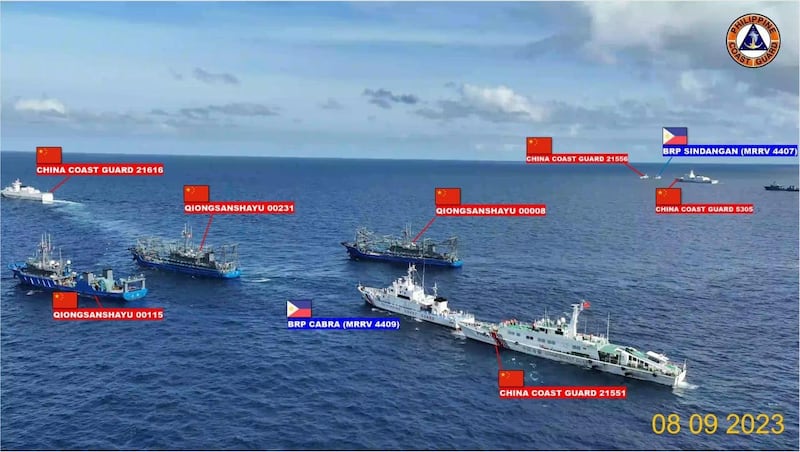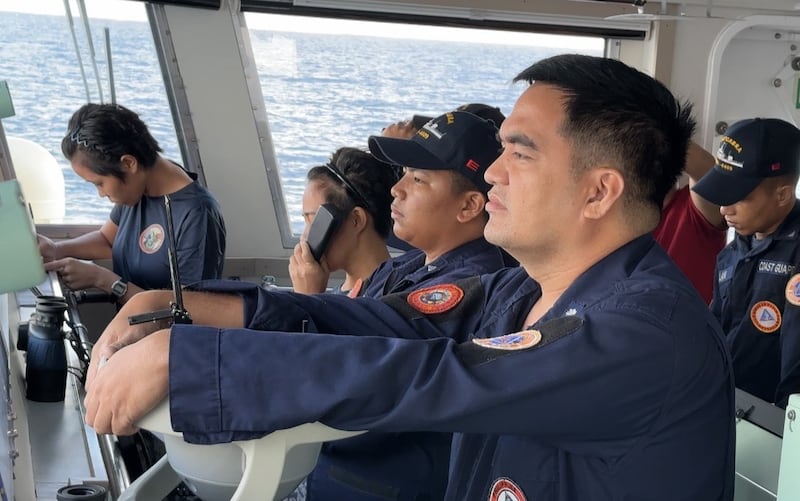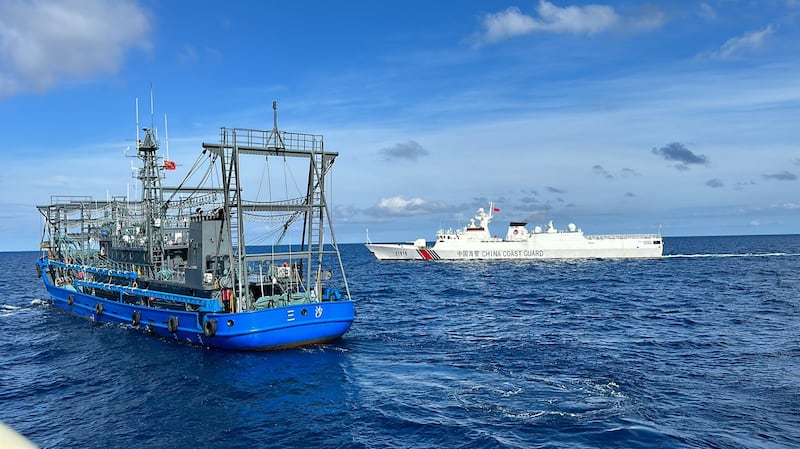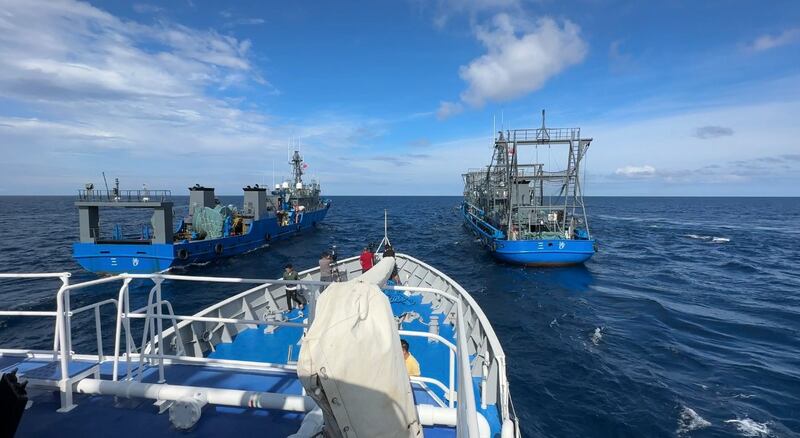The Chinese ships began to swarm around the BRP Cabra soon after 7 a.m. on Friday, sailing uncomfortably close to and hemming in the Philippine Coast Guard ship as it escorted civilian boats toward Ayungin Shoal, known internationally as the Second Thomas Shoal.
A China Coast Guard ship, with bow number CCG 21616, was the first to arrive on scene some 10 nautical miles (18.5 km) from the shoal located in South China Sea waters within the Philippines exclusive economic zone.
A BenarNews correspondent and other reporters, who were given special permission to travel aboard the Cabra and another coast guard ship for the resupply mission, witnessed the tense moments at sea.
Similar scenes where Chinese ships acted aggressively had played out lately during previous Philippine missions to deliver supplies to the BRP Sierra Madre, a rusty old navy ship that serves as Manila's military outpost at Ayungin (Second Thomas) Shoal.
“Philippine vessel, you are approaching the waters of China. To avoid miscalculation and misunderstanding, please inform your intention,” the China Coast Guard ship radioed to the BRP Cabra at around 6:30 a.m.
The Cabra radioed back, saying it was “conducting lawful routine maritime patrol within the Philippines’ exclusive economic zone in accordance with international and Philippine laws.”
“Request to stay clear from our passage in accordance with collision regulations,” the radio operator said from the Cabra’s bridge.
About 30 minutes later, at least three other CCG ships and vessels from China’s maritime militia fleet joined the fray.
The Chinese ships then executed maneuvers to try to impede the civilian boats’ passage that Philippine Coast Guard officials described as dangerously close.
A CCG vessel, with bow number 21551, repeatedly tried to cut the Cabra’s path to separate it from one of the supply boats.
After failing to overtake the Cabra from the right side, CCG 21551 then sped up to overtake it from the left side. As the Chinese ship executed this maneuver, it sailed toward the Cabra and then abruptly stopped only three to five meters (9.8 to 16.4 feet) from the Philippine ship, PCG officials said.
During the standoff, at least a dozen more radio exchanges as well as challenges and counter-challenges ensued between the Philippine and Chinese ships.
“Your behavior has infringed upon [the] authority, security, and interest of China. I warn you, please leave the area immediately. Any consequences will be borne by you,” a voice from CCG 5305, the largest of the China Coast Guard ships present, warned the Cabra’s crew.
After being separated from their PCG escort ships, as the Chinese ships had intended, the Filipino civilian boats managed to sail on, reach the Sierra Madre, pick up Philippine Navy personnel and deliver food and other supplies.
The coast guard rated the latest mission a success, despite the tense encounter with the Chinese vessels.
“The routine RoRe [rotational and resupply] mission was again subjected to dangerous maneuvers, jeopardizing the crew members’ safety aboard the PCG vessels and Philippine supply boats,” Commodore Jay Tarriela, the Philippine Coast Guard spokesman on the West Philippine Sea (South China Sea), said in a statement to media.

During Friday’s incident, the PCG said it had recorded 10 instances of dangerous maneuvers carried out by four CCG ships and four Chinese maritime militia ships toward the BRP Cabra and another Philippine Coast Guard ship, the BRP Sindangan.
Two Chinese warships from the People’s Liberation Army Navy were also spotted monitoring the area.
At one point, CCG 5305 blew its horn three times while crossing the bow of BRP Sindangan at a distance of approximately 50 to 60 yards.
The BRP Cabra, for its part, was corralled by five Chinese ships: three maritime militia vessels and a CCG ship in front, and another CCG ship behind.
Overnight journey
The crews of the Cabra and Sindangan, 44-meter-long (144.3-feet-long) coast guard multi-purpose response vessels, and the journalists aboard them had left the Philippine island of Palawan at around 9 a.m. on Thursday.
The coast guard ships were deployed to escort two small supply boats, the Unaizah May 1 and Unaizah May 2, which the Philippine Navy had commissioned for its routine rotational and resupply mission.
The wooden boats were transporting food, supplies, and a new batch of sailors headed to the Sierra Madre, a decrepit World War II-era ship. In 1999, the Philippines deliberately ran it aground in Ayungin Shoal, which lies in the contested Spratly Islands, in response to China’s occupation of nearby Mischief Reef.
The two Unaizah May boats and the PCG vessels met up near Sabina Shoal late Thursday night, with the two smaller ships sailing between the coast guard ships.
“That was the instruction to us, protect the Unaizah May boats,” Emmanuel Dangate, the commander of the Cabra, told the reporters aboard his ship.

View from the bridge
During Friday’s standoff, the atmosphere on the bridge of the Cabra was quiet and sober as the Chinese ships closed in on the PCG ship. Some of the crew were even smiling and joking around.
Dangate, the Cabra’s skipper, remained calm as he gazed ahead from the bridge and gave orders to his crew.
“During this kind of mission, it ignites our patriotism and dedication,” the commanding officer told the select group of reporters, who had been allowed to travel to get a rare first-hand view of one of the Philippine resupply missions.
From time to time, he would look through his binoculars and ask brief questions to his team.
“Does that ship have an AIS [automatic identification system]?” he asked, pointing to a distant vessel that appeared to be a Chinese militia ship.
“None, sir,” a junior crew member replied. This meant that some of the Chinese vessels were turning off their automatic identification systems so as to conceal their positions and technical information from other vessels in the area.

As the standoff unfolded, a P-8A Poseidon reconnaissance plane from the United States Navy, Manila’s main defense ally, repeatedly overflew the area during and after the incident. An unidentified Black Hawk helicopter, according to PCG officials, tried to reach the wooden boats. An unidentified white aircraft was also spotted.
The maritime militia vessels and the CCG ships continued to closely guard the PCG vessels for hours as the Philippine ships waited for the supply boats to return from Ayungin Shoal. The Chinese vessels finally dispersed when the Philippine ships set sail at around 3 p.m. on Friday for their return trip to Palawan.
Philippine authorities pointed out that unlike in past resupply missions, China has now deployed its smaller CCG vessels, which are more quick to maneuver to block Philippine vessels.
During the previous resupply mission, on Aug. 22, the two PCG ships were able to escort the civilian boats a bit closer to the shoal despite China’s moves. But this time, they were able to reach only 10 nautical miles from the shoal, with Tarriela citing the use of smaller and faster CCG vessels as a possible reason.
Noticeable, too, was the more active participation of maritime militia vessels in harassing Philippine vessels during recent resupply missions, officials said.

A dispute with China over the Spratly chain was at the heart of Manila’s decision in 2012 to bring an international lawsuit against Beijing in 2012.
The Philippine case was considered groundbreaking because it no country had previously challenged China in a world court over its territorial claims in the waterway.
In 2016, the Permanent Court of Arbitration in The Hague ruled in favor of the Philippines in a landmark verdict that invalidated Beijing’s sweeping territorial claims in the South China Sea, an important gateway for global trade.
Beijing, however, has refused to acknowledge the award, citing history by insisting that the islands are part of its territory.
BenarNews is an online news outlet affiliated with Radio Free Asia.
